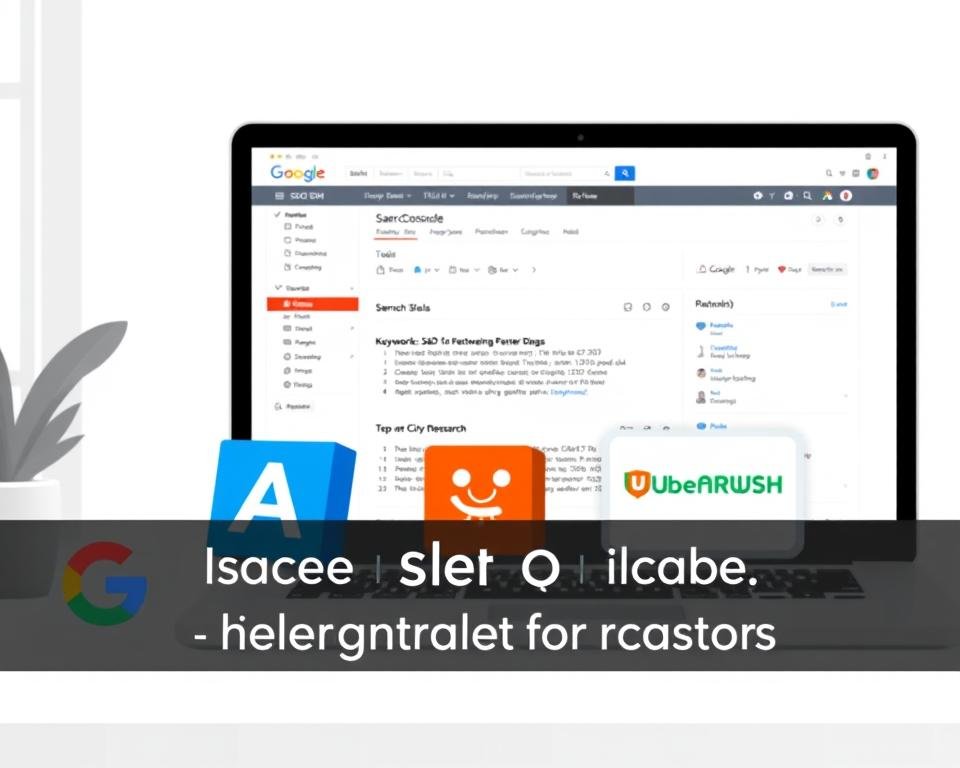As a blogger, I know how key it is to have a strong online presence. Using long-tail keywords can really help. It boosts your site’s visibility and brings in more visitors.
Targeting specific phrases with less competition can help you rank higher. This is great for online content creators who want to reach more people.
Key Takeaways
- Identify relevant long-tail keywords to target your audience effectively.
- Use tools like Google Keyword Planner to find the best keywords.
- Optimize your content with the chosen long-tail keywords.
- Monitor your website’s performance using analytics tools.
- Adjust your SEO strategy based on the performance data.
Understanding the Importance of SEO for Parenting Blogs
To succeed as a parenting blogger, knowing SEO basics is key. I’ll explain what SEO is, why it’s important for parenting blogs, and clear up common myths.
What Is SEO?
SEO means “Search Engine Optimization.” It’s about making your website more visible in search results. Effective SEO means knowing how search engines work and what people search for.
By optimizing your blog, you can get more visitors and reach your audience better.
Why SEO Matters for Parenting Blogs
SEO is vital for parenting blogs. It helps you find parents looking for parenting info, advice, and products. By using the right keywords, you can:
- Get more visibility in search results
- Attract more visitors to your site
- Show you’re an expert in parenting
Common SEO Misconceptions
There are many SEO myths that can slow you down. These include:
- Thinking SEO is a one-time job, not an ongoing effort
- Believing keyword stuffing works
- Assuming SEO is just for search engines, not readers
Knowing these myths and avoiding them can help you create good SEO strategies for your blog.
Identifying Your Target Audience
The first step in making a great parenting blog is knowing who you’re writing for. It’s important to understand your readers’ needs and what they want to see. This way, you can make content that really speaks to them.
Defining Your Ideal Reader
To make content that works, you need to know who your ideal reader is. Think about their age, interests, and what they struggle with. Are they new parents or have they been doing it for a while? What worries them, and how can you help with your blog?
Key things to think about include age, where they live, and what stage of parenting they’re in. For example, a blog for young city parents might talk about work-life balance. On the other hand, a blog for rural parents might cover how to find resources when they’re far away.
Conducting Reader Surveys
One good way to learn about your audience is through surveys. Surveys can show you what your readers like, what they worry about, and what they expect. You can use online tools to make and share surveys with your readers. Ask questions that help you understand their needs better.
Some important questions to ask are: What topics interest you most? What are your biggest parenting challenges? How do you like to get information? By asking the right questions, you can get feedback that helps you make content your audience will love.
Utilizing Analytics Tools
Another way to get to know your audience is by using analytics tools. Tools like Google Analytics can tell you a lot about your readers, like who they are and how they interact with your blog. By looking at this data, you can spot trends and improve your blog.
Important things to watch include page views, bounce rate, and how long people stay on your site. By keeping an eye on these, you can see what works and what doesn’t. This helps you make better choices for your blog.
What Are Long-Tail Keywords?
Long-tail keywords are key for a good SEO plan for parenting blogs. They are specific phrases with lower search numbers. But they are also less competitive and more focused on your content.

Characteristics of Long-Tail Keywords
Long-tail keywords stand out for their value in SEO. They are longer phrases, often with three or more words. They are very specific. For example, “parenting tips for toddlers” is a long-tail keyword instead of just “parenting tips.” This makes them great for attracting the right audience.
How Long-Tail Keywords Differ from Short-Tail
Long-tail and short-tail keywords differ in their detail and search numbers. Short-tail keywords are broad and have lots of searches. But they are also very competitive. Long-tail keywords are more detailed, have fewer searches, and are easier to rank for.
Key differences include:
- Specificity: Long-tail keywords are more specific than short-tail keywords.
- Search Volume: Long-tail keywords have lower search volumes compared to short-tail keywords.
- Competition: Long-tail keywords are less competitive, making it easier to achieve a higher ranking.
Benefits of Using Long-Tail Keywords
Using long-tail keywords in your parenting blog has many benefits. They help target specific searches, reduce competition, and boost the chance of turning visitors into loyal readers. By adding long-tail keywords to your content, you can make your blog more visible and attract a more engaged audience.
The benefits include:
- Targeted Traffic: Attract visitors who are searching for specific information.
- Less Competition: Easier to rank for less competitive terms.
- Higher Conversion Rates: More targeted content leads to higher engagement.
Tools for Researching Long-Tail Keywords
Finding the perfect long-tail keywords is key. I’m here to show you the best tools. As a blogger, you know how important long-tail keywords are. But finding them can be tough.
Many tools have become leaders in SEO. Let’s look at some top SEO tools for parenting blogs for finding long-tail keywords.
Google Keyword Planner
Google Keyword Planner is a must-have for SEO. It helps you find keywords, see how often they’re searched, and check the competition. Start by typing a keyword related to your content. Then, look at the suggested keywords and their search volumes.

Ubersuggest
Ubersuggest is a strong tool for keyword suggestions, search volume, and competitor analysis. It finds content gaps by looking at what your competitors do.
Use Ubersuggest to find long-tail keywords. Then, sort them by relevance and search volume.
AnswerThePublic
AnswerThePublic shows search data in a unique way. It helps you see what questions people ask about your topic. It’s great for finding question-based long-tail keywords.
With AnswerThePublic, you can find lots of content ideas and keywords. These directly answer your audience’s questions.
Using these tools helps you create a strong SEO plan. It targets the right audience with the right content. Success comes from knowing your audience and using the right tools to find long-tail keywords.
Crafting Your Content Around Long-Tail Keywords
Using long-tail keywords is key to boosting your parenting blog’s ranking. These specific phrases help you meet your audience’s needs and questions.

Creating Quality Content
To rank better, make high-quality, engaging content that adds value. Know what your readers need, want, and like. Good content answers their questions, not just uses keywords.
Quality content has:
- Relevant and timely info
- Grabbing headlines and subheadings
- An easy-to-read format
Understanding Search Intent
Knowing why people search for your keywords is important. It’s not just about using keywords. You must match what users are looking for.
For instance, “how to discipline a toddler” is likely an informational search. Your content should offer clear, helpful tips.
Using Keywords Naturally
After understanding search intent, use your keywords naturally in your content. Don’t stuff keywords, as it hurts your ranking. Make your keywords feel natural and organic.
Write for your audience first. Use keywords in:
- Headings and subheadings when it makes sense
- The first paragraph to set the scene
- Throughout, but naturally and varied
By focusing on quality, intent, and natural keyword use, you’ll boost your blog’s visibility and ranking.
Optimizing Blog Posts for SEO
To make your parenting blog more visible, you need to optimize your posts well. This makes your blog easier to find on search engines. It also makes your content better for your readers.

Best Practices for Title Tags
Title tags are key for SEO. They tell search engines what your page is about. Make sure your title tags are clear, short, and have your main keyword. For example, “Parenting Tips for New Parents: A Beginner’s Guide” is a good title tag for a parenting blog.
Writing Meta Descriptions
Meta descriptions give a quick summary of your post. They show up in search results. A good meta description can get more people to click on your post. Include your main keyword and keep it short, under 160 characters.
Headers and Subheaders
Headers and subheaders (H1, H2, H3, etc.) organize your content. They help readers follow your content and highlight important points. This makes your content easier to read and helps search engines understand it better.
By following these SEO tips, you can make your parenting blog more visible. This will bring in more visitors and give them a better experience.
Enhancing User Experience
To keep readers engaged, focus on making your blog better. A good user experience keeps visitors coming back. It also makes them share your content, helping your blog get seen more.
Make sure your blog works well on all devices. This is where mobile responsiveness is key.
Mobile Responsiveness
Most people use mobile devices to browse the web. So, having a mobile-friendly blog is a must. It should look great on any screen size, making reading easy.
To make your blog mobile-friendly, do these things:
- Use flexible grids and layouts.
- Optimize images for various screen sizes.
- Ensure that buttons and links are easily clickable on smaller screens.
Fast Loading Times
Fast loading is also important for a good user experience. Slow sites can make people leave quickly. This hurts your SEO. To speed up your site, try these:
- Optimize images and compress files.
- Use browser caching.
- Use fewer heavy scripts and plugins.
Google says a 1s to 3s delay in page load time can increase bounce by 32%. This shows how fast loading is key to keeping visitors.
| Loading Time | Probability of Bounce |
|---|---|
| 1s | Low |
| 2s | Moderate |
| 3s | High (32% increase) |
Easy Navigation
It’s important to make it easy for readers to find what they need. A good menu, clear categories, and a search bar help a lot. Think about:
- Organizing content into relevant categories.
- Using clear and concise labels for menu items.
- Incorporating a search bar to help users find specific content.
By improving these areas, you make your parenting blog more engaging. This helps your blog get seen more through better SEO.

Internal and External Linking Strategies
To make your parenting blog more visible, use smart linking strategies. Linking is key for SEO and makes your blog more credible. It also helps with search engine rankings.
Importance of Internal Links
Internal links connect pages on your own site. They help search engines understand your site’s structure. They also make it easier for readers to find more content.
Link to content that’s useful and adds value. For example, if you’re sharing parenting tips, link to other articles with more advice.
Benefits of Internal Linking:
- Improved site navigation
- Enhanced user experience
- Better search engine crawling
Building External Backlinks
External backlinks come from other sites linking to yours. They show search engines your blog is credible. To get these links, create content that’s valuable and relevant.
Guest posting on other blogs is a good way to get backlinks. You can also share your knowledge in online parenting communities.
| Method | Description | Benefits |
|---|---|---|
| Guest Posting | Writing articles for other reputable blogs | Increased backlinks, improved credibility |
| Community Participation | Engaging in online forums and discussions | Establishes authority, generates backlinks |
| Content Creation | Producing high-quality, linkable content | Attracts natural backlinks, enhances SEO |
How to Identify Link Opportunities
Find link opportunities by analyzing your content. Use tools like Ahrefs or SEMrush to see what your competitors are doing. This can help you find places to add links.

By using these linking strategies, you can boost your SEO. This will improve your blog’s credibility and authority in the parenting niche.
Leveraging Social Media for SEO
Using social media can help your parenting blog get more visitors. Social media sites are great for growing your online presence. They can also bring in more readers.

Choosing the Right Platforms
Not all social media sites are the same. You need to find where your readers hang out. For parenting blogs, Instagram and Pinterest are good choices because they are all about pictures.
Think about what kind of content you share and who reads it. For example, if you have lots of videos, YouTube is a great place to be.
Promoting Blog Posts Effectively
After picking your sites, it’s time to share your blog posts. Make sure your posts grab people’s attention and make them want to visit your blog.
- Use catchy headlines and descriptions.
- Use hashtags to get more people to see your posts.
- Share a little bit of your blog content.
This way, you can get more people to visit your blog. And that can help your SEO.
Engaging with Your Audience
On social media, it’s not just about posting. It’s also about talking to your followers.
Answer comments, ask for opinions, and join in on discussions. This builds a community around your blog. A community that can share your posts, link to them, and help your SEO.
Being consistent is important. Post regularly and talk to your followers often. This keeps your site visible and your followers interested.
Monitoring Your SEO Performance
Effective SEO for parenting bloggers needs constant checking. To see if your plans are working, you must watch your SEO performance often.
Key Metrics to Track
There are key metrics to watch when checking your SEO. Look at organic traffic to see how many search engine visitors you get. Also, check keyword rankings to see how your content ranks for certain words.
Don’t forget to track bounce rate and conversion rate. Bounce rate shows how interesting your content is. Conversion rate tells you how many visitors do what you want them to.
Analyzing Traffic Sources
It’s important to know where your visitors come from. Look at your traffic sources to see how well your SEO works compared to social media or paid ads.
By finding out which sources bring the best traffic, you can use your resources better.
Making Data-Driven Adjustments
After you’ve looked at your SEO data, it’s time to make changes. You might need to improve underperforming content, change your keyword strategy, or make your site better for users.
The aim is to use what you learn from your data to make your SEO better.
Staying Updated with SEO Trends
SEO is always changing. It’s key for parenting bloggers to keep up with new trends and best practices. Search engines and how people use them change often. So, bloggers need to update their strategies to stay visible.
To stay ahead, there are a few important steps. Following leading SEO blogs is a great way to learn about new SEO news and tips.
Following Leading SEO Blogs
SEO blogs like Moz, Ahrefs, and Search Engine Journal are full of useful info. They talk about the latest SEO trends, updates, and how to improve your blog’s ranking.
- Moz: Offers detailed guides and articles on SEO strategies and techniques.
- Ahrefs: Provides tools and resources for keyword research, backlink analysis, and content optimization.
- Search Engine Journal: Publishes news, tips, and guides on SEO and digital marketing.
Participating in Online Communities
Joining online communities about SEO and parenting blogging is also helpful. Sites like Reddit’s r/SEO and r/Blogging, and Facebook groups for SEO and parenting, let you connect with others. You can ask questions and share your knowledge.
- Reddit: A platform with various subreddits dedicated to SEO and blogging.
- Facebook Groups: Groups focused on SEO and parenting blogging where members can share experiences and advice.
Attending SEO Webinars
Going to SEO webinars is another good way to learn. These webinars have experts sharing the latest SEO trends and strategies. They’re a chance to learn from others and ask questions live.
- Industry conferences: Events where SEO experts gather to share their knowledge.
- Online webinars: Virtual events that offer insights into the latest SEO trends.
By following SEO blogs, joining online communities, and attending webinars, you can keep up with SEO trends. This helps you improve your blog’s SEO and reach more people.
Conclusion: Taking Action with SEO
Now you know a lot about SEO for parenting blogs. It’s time to use what you’ve learned. By following the best tips from this article, you can make your blog more visible. This will bring more visitors to your site.
Putting Knowledge into Practice
Begin by using SEO strategies that fit your blog and readers. Make sure your content is top-notch and engaging. Use long-tail keywords in a natural way. This will draw in the right people and boost your rankings.
Creating an Ongoing SEO Strategy
SEO is a continuous process, not a one-time job. Keep an eye on how well your SEO is doing. Look at where your visitors come from and adjust your plan based on data. This way, you’ll stay ahead in the SEO world and keep your online spot.
Achieving Success with SEO
As you start using these tips, you’ll see your blog grow. Celebrate every success, like more visitors or better rankings. Stay true to your SEO plan, and you’ll reach your online goals.
